In the real world, a backlog means the accumulation of uncompleted tasks. In college, backlog is an exam you haven’t passed yet. “I have a huge backlog” isn’t a good thing. However, that is not the case in agile product development.
In agile scrum, the product backlog is a wishlist or a future plan, while the sprint backlog is the planned task list for a sprint. While the word backlog still means tasks not yet completed, its purpose in agile is distinct.
But first, let’s understand backlogs.
What is a Product Backlog?
A product backlog is a list of tasks, features, user stories, and bug fixes the development team will work on while executing the product roadmap. It is characterized by the following.
- Acts as the single source of requirements for the development team
- Breaks down the high-level organizational vision into tasks
- Prioritizes the items and features on the product roadmap
- Stays dynamic, evolving with the needs of the market, consumer, and organization
What does the product backlog contain?
Essentially, a product backlog contains everything that agile teams need to work on. This can be:
- New features
- Existing feature enhancements
- Bug fixes
- Customer requests
- Action items from the retrospective
- Technical debt
- Infrastructure updates
⭐ Featured Template
Prioritize features, fixes, and ideas in one place with ClickUp’s Backlog Template. Easily groom your product backlog and keep your team aligned on what’s coming next. Try it for free today!
Who owns the product backlog?
The product owner owns the product backlog, publishing it on the product management tool. However, the entire cross-functional team and the scrum master take responsibility for creating, updating, and maintaining it.
How is the product backlog different from the product roadmap?

The product backlog is a detailed breakdown of the product roadmap. While the roadmap communicates high-level objectives and direction, the backlog includes task-level details on its execution.
The roadmap supports the business teams and managers, while the product backlog is for the developers. The roadmap focuses on metrics and goals, while the product backlog outlines tasks and action items.
What does the product backlog look like?
Here is a product backlog example. We’ve considered the features of an online multiplayer game. Each feature is assigned a story point, and the backlog items are ordered based on their priority, with the highest priority (priority=1) item at the top.
| User Story | Story Point(s) | Priority |
|---|---|---|
| As a gamer, I want to invite my friends so we can play together | 1 | 1 |
| As a gamer, I want a practice mode so I can learn how to play | 2 | 2 |
| As a gamer, I want to have in-app chat so that I can talk to other players in real time | 3 | 2 |
| As a gamer, I want to compare heroes so I can choose the right one for me | 4 | 3 |
| As a gamer, I want resources that boost my hero’s health and mana regen | 3 | 3 |
| As a gamer, I want in-game money so I can purchase hero customizations | 3 | 4 |
For a sample of what it might look like for you, see the ClickUp project backlog template. You can customize it for your product instantly, too!
Benefits of Having a Product Backlog
As one of the foundational scrum artifacts, the agile backlog offers structure and actionability to product development. Here’s how.
Team agility
The product owner shares the product backlog with the entire team, opening it up for discussion before every sprint. The team prioritizes together, having conversations around what’s important. These discussions create better collaboration among team members, supporting innovation.
Iteration planning
An agile scrum team adds all tasks to the backlog. For each iteration in agile projects, the team evaluates the backlog, identifies items for development, discusses trade-offs, and creates the sprint backlog.
Anchor for work
When the developers take items from the backlog to develop, they are anchored to it. It prevents them from deviating from the plan or feeling lost in the middle of the sprint.
Accommodating feedback
An agile product backlog documents feedback from customers/users as well as action items from team retrospectives. This helps in continuous improvement, which is foundational to agile product development.
With all these benefits and more, product backlogs play a critical role in the agile framework.
The Role of Product Backlog Management in Agile
The product backlog serves a specific purpose within the agile software development framework. The product development journey looks as follows.
Product vision > Product strategy > Product roadmap > Product backlog > Sprint backlog > Product release
In this journey, the product backlog converts the vision and roadmap into actionable tasks. It helps leadership see how their vision will be executed. It shows the development team how their daily work contributes to the business and serves as the superset of features for sprint backlogs.
A healthy product backlog is the primary determinant of an effective sprint backlog.
Product backlog vs. sprint backlog
| Product backlog | Sprint backlog | |
|---|---|---|
| Purpose | Lists tasks that the team can perform in upcoming sprints | Lists tasks that the team has committed to completing in the next sprint |
| Size | Superset of tasks | Subset of the product backlog |
| Items | Product features and customer requests | User stories with software requirement |
| Duration | Ongoing | Each sprint |
| Ownership | Product owner | Development team |
| Reporting | Dashboard with number of features, points, and time estimated | Sprint burndown chart |
How to Prioritize Product Backlog Items?
One of the critical jobs of the product owner in product backlog management is prioritization. The product owner decides what the team must focus on to maximize value.
Parameters for backlog prioritization
Therefore, the critical parameter for prioritizing product backlog items is value. Business value can be any of the following.
- Customer needs or satisfaction
- Revenue or profitability
- Risk management or compliance
- Product differentiation for competitive advantage
The value used to prioritize backlog can also be internal and defined at an engineering level.
- Time to develop a feature
- Resources/costs needed to develop
If you need help, the Aha! product management software can help identify these parameters by connecting strategic goals to everyday tasks.
Backlog prioritization techniques
You can follow any of the following techniques based on the value you choose to prioritize.
Kano model: Plotted on a graph, the Kano model compares customer delight to implementation investment. It helps teams prioritize features likely to satisfy customers and realize investment.
MoSCoW model: This is an abbreviation for must-have, should-have, could-have, and won’t-have, helping teams prioritize the essential features over clutter.
Cumulative voting: Every stakeholder is given 100 points—or figurative dollars—that team members can spend on the features of their choice. The features most paid for are the ones that get prioritized.
Stack ranking: Instead of listing and prioritizing all items, this method stacks one user story against another and makes individual decisions about priority.
Smallest effort first: If the team needs quick wins, the product owner prioritizes the easiest or simplest tasks.
Cost of delay: With this method, you prioritize tasks with the most opportunity cost. If moving a feature development by two weeks will cost something, such as a lost business opportunity or vulnerability in the product, you prioritize that from the backlog.
Managing a product backlog can be challenging, with so many factors influencing prioritization and so many techniques. Here are some of the common challenges product teams face.
Challenges in Managing a Product Backlog
Ambiguous user needs: One of the biggest challenges of managing a product backlog is not knowing clearly what the customer wants. Vague user stories can derail development.
Overloaded backlog: A product backlog isn’t a dump of every idea everyone ever had. It is a refined list of features/tasks that make business sense. The backlog can become unwieldy if the product owner cannot eliminate unimportant/irrelevant user stories.
Decision fatigue: An unwieldy backlog means too many decisions for the product manager. This can be overwhelming and lead to decision fatigue.
Aged backlog: A product backlog needs to be updated to be helpful. If your team either neglects the backlog or doesn’t update it, it can become irrelevant and, therefore, not adopted.
Incomplete definition: Every item on the backlog needs to be clearly defined. Managing the backlog becomes challenging when business users and product owners don’t do this.
Changing priorities: While agile teams expect and can adapt to evolving needs, changing priorities in the middle of a sprint can be disruptive.
All of these challenges can be overcome with a clear, strategic, and collaborative product backlog management process.
How to Create and Manage a Product Backlog
Creating and managing the product backlog is one of the product owner’s most critical responsibilities. Getting it right will set the foundation for successful agile product development.
You need a comprehensive, flexible, and efficient way to create backlog items and manage your product backlog. There are several product backlog management tools available in the market today.
Here’s how you can use a tool like ClickUp for product management to get it right.
1. Use your product roadmap
The product roadmap is the starting point for creating your backlog. It distills the organizational and product vision into direction and gives the business perspective fundamental to engineering efforts.
So, understand the product roadmap clearly and use it to guide your development journey. Visual roadmaps on ClickUp can help engineering, product, and business teams rally toward the same goals.
2. Collect potential features for the backlog
The roadmap is the first of many sources that can suggest features for your product backlog. Here are some insightful places to look.
User research: Conduct user research to help you identify what users want. A simple survey using ClickUp Forms can be a great starting point.
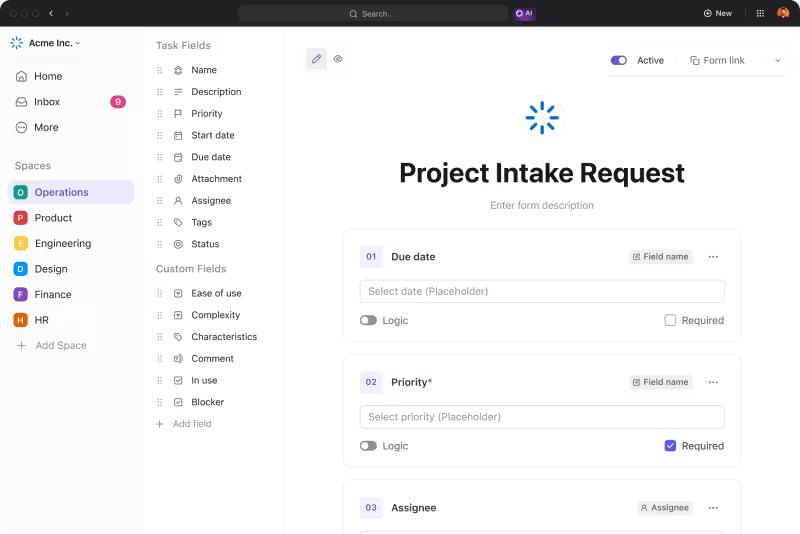
Customer feedback: The complaints, issues, and tickets users raise help you understand what customers don’t want. You can also find this data in product reviews.
QA team: Quality analysts are your first users. Have detailed conversations with them to understand what works and what doesn’t. Make a note of insights from these conversations on ClickUp Docs and share them with the team.
Sales team: They are the closest to the customer. Ask them what customers are saying and build your backlog accordingly. Use ClickUp Docs to connect the various records, insights, and workflows.
Competition analysis: See what products similar to yours are building for inspiration. But remember to be very careful when you do this. You don’t want to make just another copycat product.
3. Organize product backlog items
Now that you have a number of items that could be developed, it’s time to organize them so that they can be managed efficiently.
Set up backlog items as tasks
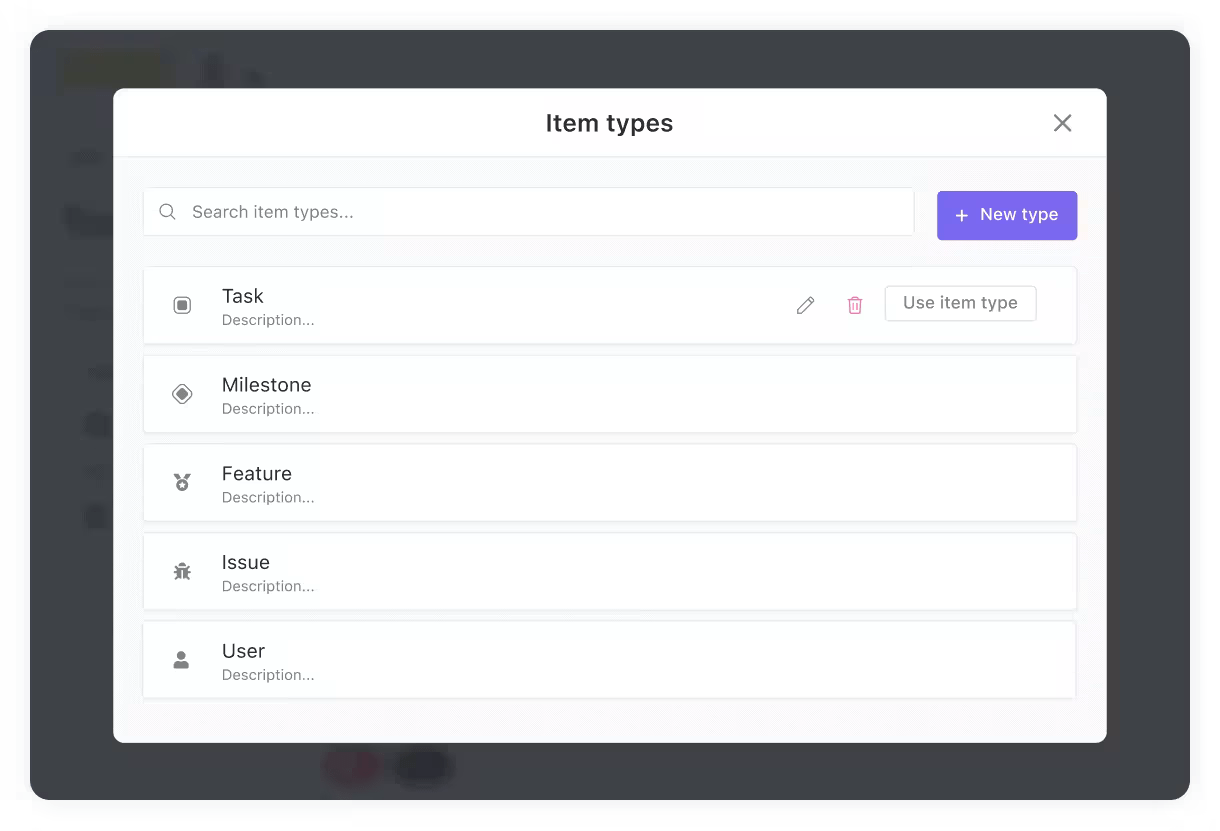
Set up each backlog item on ClickUp tasks categorized as task, feature, defect, feedback, and more. Add further information, such as:
- Detailed descriptions, sub-tasks, and checklists
- Users and watchers
- Due dates and time estimates
- Custom fields to support your unique processes
Not sure where to start? No sweat. Choose from these ten free product backlog templates to beat the blank page.
Add the information needed to prioritize
Product backlog items will be prioritized only if they deliver business value. Add the necessary information depending on the parameters you choose to determine the value and techniques you intend to use for your backlog prioritization.
For example, if your value is the time taken to build the product, the Sprint Points ClickApp allows you to assign story points to each item based on the effort required to complete it.
Prioritize product backlog items for development
Backlog prioritization is an integral part of the product development process. It is the product owner’s responsibility to ensure that the right items are prioritized for development. Keep the following factors in mind while prioritizing tasks.
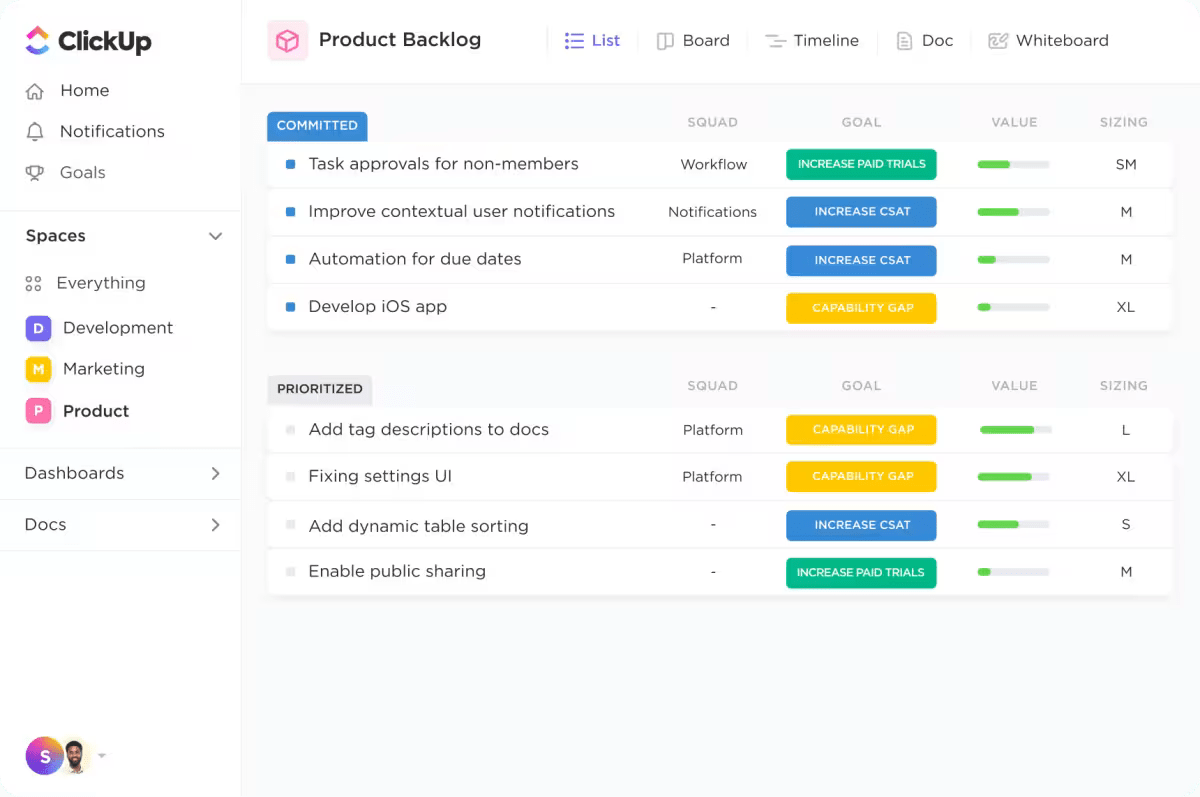
- Make sure you have enough information about value, deliverables, and measures of success
- Sort them based on the weights and evaluation criteria you’ve defined
- Be the gatekeeper for what features are prioritized
- Don’t block ideas as much as possible, de-prioritize them instead
- Once you’ve made the prioritization decisions, set priorities on ClickUp
Agile experts recommend having a deep product backlog, which means that the tasks of higher priority will have more details than those of lower priority. By extension, you will keep adding details to the backlog items as they come closer to development.
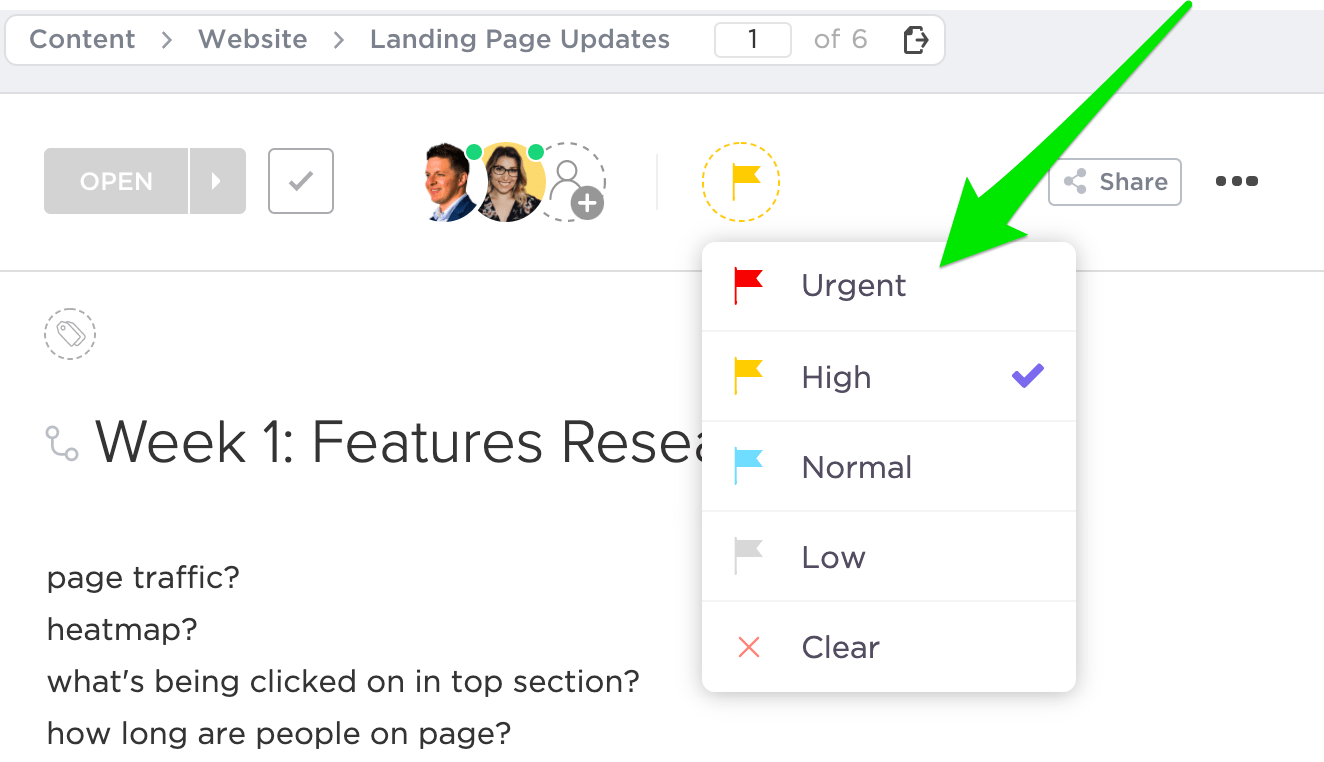
Refine product backlog
For a healthy pipeline of work for the future, you need regular product backlog refinement. Also known as backlog grooming, this exercise aims to:
- Eliminate outdated items or user stories
- Add newly discovered ones
- If you have user stories too large for one sprint, break them down
- Re-evaluate priorities and estimates
- Set the right statuses so it is easy to access the ClickUp Kanban board
Maintain the product backlog
In addition to the above steps, the product owner is responsible for maintaining the product backlog in healthy condition.
Clean up the product backlog: A bit of this will be done in refinement before sprints. Ensure you also mark all the completed items as done and archive them.
Communicate the product backlog: Create custom views for the team and other business stakeholders to keep them updated on the backlog in real time.

The Kanban board view is excellent for the development team. A ClickUp Dashboard of key metrics and performance is perfect for business leadership.
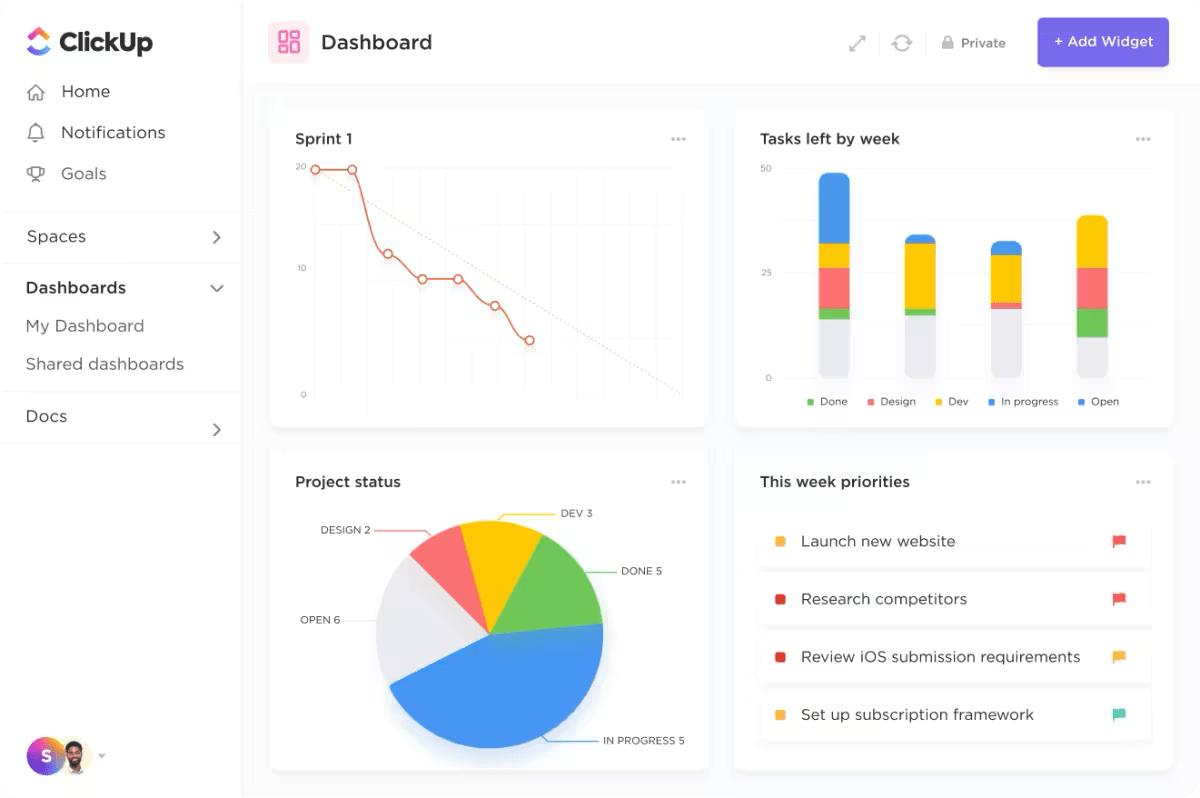
Use the backlog in retrospectives: The product backlog will likely have the feature’s history. Use the information here to support your retrospectives, sprint review, and future iteration plans.
Like every process in agile, rinse and repeat your product backlog management. Strive for continuous improvement.
Effortlessly Manage Your Product Backlog with ClickUp
A product backlog can be your superpower or Achilles heel, depending on how you wield it. An updated, comprehensive, clearly defined, and communicated backlog can steer product development in the right direction. ClickUp is designed to enable this!
With ClickUp’s lifecycle management software, you can plan, build, and ship all in one place. From documenting conversations and insights on beautiful project wikis to creating reports for retrospectives, ClickUp has got you covered.
What’s more? ClickUp AI fast-tracks your development plans and documentation. It helps you generate product ideas, roadmaps, and documentation with expert-crafted AI tools within ClickUp.Don’t take our word for it. Try ClickUp for free today.





